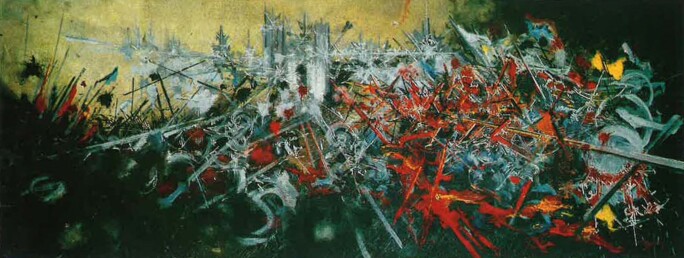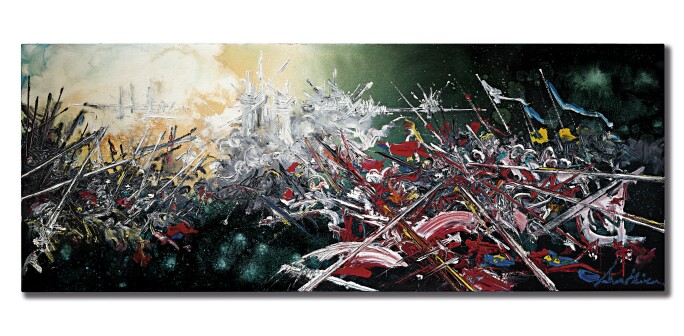Georges Mathieu, 1429
Spanning almost two meters, 1429 is an impressive and quintessential work by Georges Mathieu, a pioneering artist of Lyrical Abstraction and performance art. The work parades vigorous gestures, rapidly applied yet controlled lines, and an explosion of contrasting, saturated colours. The composition brings together speed, zeal and fervour, manifesting chromatic vibrance seen through rich layering. By utilizing a technique he coined ‘tubism,’ the artist squeezes paint directly onto the canvas, resulting in a textured, relief-like surface.
Titling the work 1429, Mathieu evokes a significant triumph in battle: the Seige of Orléans, the watershed of the Hundred Years' War between France and England. For many years, the English maintained military advantage in the conflict and steadily advanced into French territory. The Seige of Orléans represented the first major conquest of the French royal army to follow the devastating defeat at the Battle of Agincourt in 1415. It also marked the first while Joan of Arc (1412-1431) was with the army, canonizing her as a national hero. French leaders, such as Napoleon Bonaparte and Charles de Gaulle, have long used the image of Joan of Arc to spur patriotism and enhance troop morale. Apart from this particular series, it is important to note that Mathieu admitted a deep passion for history, particularly for the Middle-Ages. Other works named after historical battles include La Bataille de Bouvines (The Battle of Bouvines), La Victoire de Denain (The Victory of Denain) and Les Capétiens partout (Capetians everywhere).
In August 1982, Régine Pernoud, noted historian and then-director of the Association des Amis du Centre Jeanne d'Arc, commissioned Mathieu to paint La libération d’Orléans par Jeanne d’Arc, a monumental oil painting measuring 2 x 5 meters. The work was sent to a major exhibition in Tokyo with the support of the Mitsukoshi Foundation. Subsequently, La libération d’Orléans par Jeanne d’Arc was purchased by the Orléans city government, and it was exhibited for a long period in the Hôtel de Ville until it joined the Musée des Beaux-Arts d'Orléans in 2018. To express his gratitude for Pernoud’s insight and judgment, Mathieu painted La libération d’Orléans par Jeanne d’Arc (Sotheby’s Hong Kong, 5 July 2020) in September 1982 at a size suitable for a private collection. Painted in the same year, the present lot is a highly rare iteration of this theme, echoing the iconic La libération d’Orléans par Jeanne d’Arc.
When confronted with the honourable commission project of painting La libération d’Orléans par Jeanne d’Arc, Mathieu finally deviated from pure abstraction and introduced representational elements to express close combat at Orléans. In keeping with the tenets of this series, 1429 also boasts representational forms: the mighty fortifications appear along the horizon line in the distance, obscured by the explosion of combat, peppered with French flags proudly hoisted.

Georges Mathieu, La libération d'Orléans par Jeanne d'Arc, 1982, oil on canvas, 200 x 500cm, Collection of Musées des Beaux-Arts Orleans, France
When confronted with the honourable commission project of painting La libération d’Orléans par Jeanne d’Arc, Mathieu finally deviated from pure abstraction and introduced representational elements to express close combat at Orléans. In keeping with the tenets of this series, 1429 also boasts representational forms: the mighty fortifications appear along the horizon line in the distance, obscured by the explosion of combat, peppered with French flags proudly hoisted.
In the present lot, Mathieu reflects on the colours of his national flag by primarily utilizing variations of blue, white and red when painting a theme emblematic of French victory. Traditionally in Europe, white symbolizes purity and victory, and as the verse from Revelations 3:5 affirms, “He who overcomes shall be clothed in white garments, and I will not blot out his name from the Book of Life; but I will confess his name before My Father and before His angels.” In the present lot, the combat is suffused with blotches of white while the monuments of are blanketed with a fresh, white light, alluding to the impending victory of the French army and presaging the immanent end of the Hundred Years’ War.
The white lines arising from the lower parts of the composition point towards the vanishing point, leading the viewer’s eye towards what appears to be a cityscape in the distance. The artist dexterously plays with tension and release within this linear perspective, with the foreground chaotic and tightly bound, paving the way for an open-ended backdrop and clear, blue skies.
1429 hails from the artist’s mature period, when he was already celebrated as a master of abstraction. Following his experimentation with geometry and applied arts during the 1960s and 1970s, he experienced a turning point in the 1980s and returned to the anti- geometric lyricism and calligraphic vernacular of his 1950s period with a fresh and mature perspective. Painted in 1982, 1429 was executed during the final lead up to Mathieu’s ‘Barbaric Period,’ which is exemplified by its somewhat cosmic and celestial quality. The panoramic scale, vibrant palette, bold strokes and gestural movement of the present lot boasts strong wall power.
喬治·馬修《1429》
《1429》是抒情抽象主義和行爲藝術先驅喬治·馬修的代表作。此畫寬近兩米,全面展現激情澎湃的動態,綫條落筆迅速而又把控嫺熟,對比鮮明而純淨飽和的顔色綻放壯麗的視覺盛宴。構圖凝聚了速度與熱情,通過極其豐富的層次感奏響色彩繽紛的和鳴共振。藝術家純熟運用他開創的「導管主義」手法,直接把顔料擠到畫布上,營造出肌理獨特、形如浮雕的表面。
喬治·馬修將作品命名爲《1429》,意在突出這個重要的歷史年份。當年正值英法百年戰爭,法國在著名的「奧爾良之圍」中取勝。戰爭中英國長年佔取上風,對法國領土步步進迫。法蘭西軍隊自從在1415年於阿金科特戰役慘敗後,直到「奧爾良之圍」方取得首次重大勝仗。此役中聖女貞德(1412-1431)也是第一次投身戰場,一舉成爲法國民族英雄。後來很多法國領導人,包括拿破崙和戴高樂,一直藉著聖女貞德的形象來激發愛國主義和提高軍隊士氣。值得留意的是,因爲馬修酷愛歷史,尤其是中世紀歷史,所以他創作了不少歷史戰爭主題作品,除了現在這個特殊的系列外,還有《布汶戰役》、《德南大捷》和《處處是卡貝席安》。
1982年8月,時任法國奧爾良聖女貞德中心協會總監的著名史學家雷吉娜·佩奴德(Régine Pernoud)委托馬修創作《聖女貞德解放奧爾良》巨畫,尺幅達兩米乘五米。此作在三越基金會支持下送往東京作大型展覽,後來作品由奧爾良市政府購藏,長期展示於當地市政廳,直至2018年進入奧爾良美術館典藏。爲了感謝佩奴德的慧眼卓識,馬修爲她在1982年9月創作一幅尺寸更適宜私人收藏的《聖女貞德解放奧爾良》(蘇富比香港,2020年7月5日)。本作與上述兩個作品均於同年創作,是相同主題的罕有再演繹,與經典的《聖女貞德解放奧爾良》互相輝映。

喬治・馬修《聖女貞德的奧爾良解放》油畫畫布,一九八二年作,50 x 129.5 cm。2020 年 7 月 5 日香港蘇富比,成交價4,125,000 港元(532,244 美元)。
面臨《聖女貞德解放奧爾良》這個光榮的委托創作任務,馬修並非單純訴諸抽象主義,而是融入了具象元素去表現這個奧爾良的終結之戰。《1429》與整個系列的藝術原則保持一致,其中的具象形式讓人眼前一亮:透過畫面前方掩映的戰火,可以發現遠處地平綫上築構堅實的堡壘,上面驕傲地插滿法國國旗。
馬修在此作運用了紅、白、藍作爲基礎色調,和國旗顔色相呼應,營造這個象徵法國勝利的主題繪畫。白色在歐洲傳統中象徵純潔和勝利,正如《啓示錄》3:5中說道,「那得勝的,將要同樣穿上白衣,我絕不從生命冊上抹去他的名字;而且我將要在我父面前、在我父的衆天使面前,承認他的名字。」此作的戰鬥中佈滿白色圓斑,而城垣則籠罩著清新白光,示意法國軍隊即將取得勝利,窺見百年戰爭結束的曙光。
畫面下方一縷縷白色射綫紛紛指向畫中的消失點,將觀者的視綫引向遠處模糊的城市景觀。喬治·馬修巧妙地通過綫性透視將畫面效果把玩得張弛有度,前景布局緻密、一片混雜,背景露出無邊無際的澄澈藍天,顯得豁然開朗。
《1429》創作于藝術家的成熟發展時期,當時他已經成爲赫赫有名的抽象藝術大師。他在二十世紀六七十年代期間探索幾何圖案和應用藝術,後來在八十年代經歷重大轉折,回歸到五十年代的反幾何抒情主義和書法語言當中,並以嶄新和成熟的視野煥發生機。《1429》作於1982年,是喬治・馬修最後登頂「狂野時期」的精彩代表作,噴發宇宙星河般的恢弘氣勢。作品展現全景式構圖、揮灑濃烈的色彩和狂放的筆觸,迸發出無懈可擊的視覺震撼力。